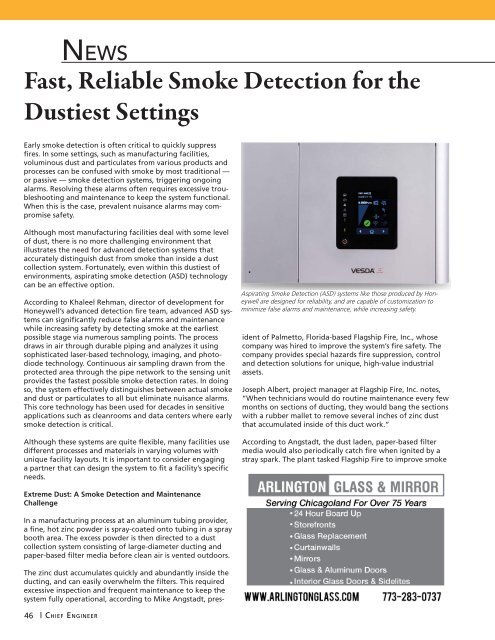CEAC-2022-05-May
Create successful ePaper yourself
Turn your PDF publications into a flip-book with our unique Google optimized e-Paper software.
News<br />
Fast, Reliable Smoke Detection for the<br />
Dustiest Settings<br />
Early smoke detection is often critical to quickly suppress<br />
fires. In some settings, such as manufacturing facilities,<br />
voluminous dust and particulates from various products and<br />
processes can be confused with smoke by most traditional —<br />
or passive — smoke detection systems, triggering ongoing<br />
alarms. Resolving these alarms often requires excessive troubleshooting<br />
and maintenance to keep the system functional.<br />
When this is the case, prevalent nuisance alarms may compromise<br />
safety.<br />
Although most manufacturing facilities deal with some level<br />
of dust, there is no more challenging environment that<br />
illustrates the need for advanced detection systems that<br />
accurately distinguish dust from smoke than inside a dust<br />
collection system. Fortunately, even within this dustiest of<br />
environments, aspirating smoke detection (ASD) technology<br />
can be an effective option.<br />
According to Khaleel Rehman, director of development for<br />
Honeywell’s advanced detection fire team, advanced ASD systems<br />
can significantly reduce false alarms and maintenance<br />
while increasing safety by detecting smoke at the earliest<br />
possible stage via numerous sampling points. The process<br />
draws in air through durable piping and analyzes it using<br />
sophisticated laser-based technology, imaging, and photodiode<br />
technology. Continuous air sampling drawn from the<br />
protected area through the pipe network to the sensing unit<br />
provides the fastest possible smoke detection rates. In doing<br />
so, the system effectively distinguishes between actual smoke<br />
and dust or particulates to all but eliminate nuisance alarms.<br />
This core technology has been used for decades in sensitive<br />
applications such as cleanrooms and data centers where early<br />
smoke detection is critical.<br />
Although these systems are quite flexible, many facilities use<br />
different processes and materials in varying volumes with<br />
unique facility layouts. It is important to consider engaging<br />
a partner that can design the system to fit a facility’s specific<br />
needs.<br />
Aspirating Smoke Detection (ASD) systems like those produced by Honeywell<br />
are designed for reliability, and are capable of customization to<br />
minimize false alarms and maintenance, while increasing safety.<br />
The zinc dust accumulates quickly and abundantly inside the<br />
ducting, and can easily overwhelm the filters. This required<br />
excessive inspection and frequent maintenance to keep the<br />
system fully operational, according to Mike Angstadt, president<br />
of Palmetto, Florida-based Flagship Fire, Inc., whose<br />
company was hired to improve the system’s fire safety. The<br />
company provides special hazards fire suppression, control<br />
and detection solutions for unique, high-value industrial<br />
assets.<br />
Joseph Albert, project manager at Flagship Fire, Inc. notes,<br />
“When technicians would do routine maintenance every few<br />
months on sections of ducting, they would bang the sections<br />
with a rubber mallet to remove several inches of zinc dust<br />
that accumulated inside of this duct work.”<br />
According to Angstadt, the dust laden, paper-based filter<br />
media would also periodically catch fire when ignited by a<br />
stray spark. The plant tasked Flagship Fire to improve smoke<br />
Extreme Dust: A Smoke Detection and Maintenance<br />
Challenge<br />
In a manufacturing process at an aluminum tubing provider,<br />
a fine, hot zinc powder is spray-coated onto tubing in a spray<br />
booth area. The excess powder is then directed to a dust<br />
collection system consisting of large-diameter ducting and<br />
paper-based filter media before clean air is vented outdoors.<br />
46<br />
| Chief Engineer


















